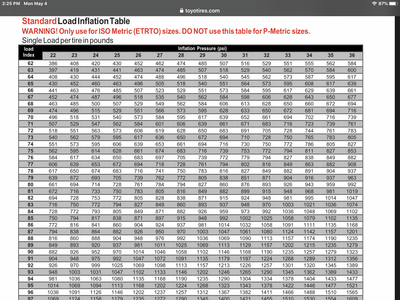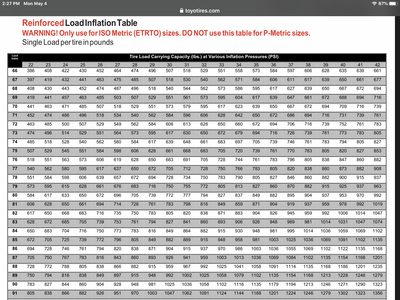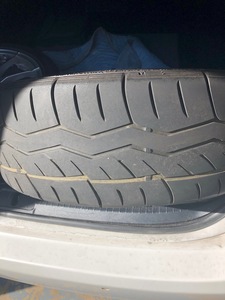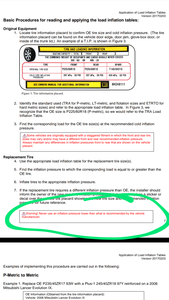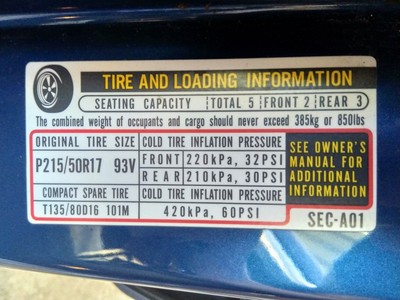How to set your air pressure using the tire load rating Chart
This is a topic that is poorly understood even by the tire industry that sells tires. It can make the biggest difference in the handling of your car and safety.
Disclaimer: The information here is meant to get you in the ball park and are approximations with using a chart from Toyo tires. Not all tires are the same for the same load rating and you might find exceptions. This guide is to get you close enough to so you can then do a temp or chalk test on your tires. Load ratings can vary but on the whole they can be close. Use the chart to look up load ratings and the weight that it carries for a comparison against the factory tires. Also factor in the weight you have already taken off the car and you can get a rough estimate.
I want to keep this concise, there are a few constants that need to be understood pertaining to the MR-S
- The factory air pressures is 26psi front and 32psi rear are chosen based on the weight of the car and the tires provided by the manufacture that has a specific load rating.
- The OEM load ratings are 81 SL front and 85 SL rear. SL stands for standard load.
- This translates roughly to 800 lbs front and 1000 lbs rear +/- 100lbs of weight that needs to be supported depending on how heavy or light your car is compared to factory.
There are some concepts that need to be understood.
- The car is supported primarily by the air pressure.
- When you buy aftermarket tires they will most likely have different load ratings from the original tires and this is to support a wide range of vehicles.
- There are 2 types of tires. SL which is standard load and XL which is extra load or reinforced. XL tires are reinforced so they can hold more air pressure and thereby can handle more weight. SL tires on average can hold 40psi max safely where as XL tires can hold 50psi. XL tires are not common and are usually found on cars that have lower profile sidewalls to increase their strength for plus sizing. One of the confusions with XL tires is their load index rating as its different then the SL by around 3 for the same weight. For example an SL tire that is rated at 87 load index will most likely be equal for an XL tire at the same air pressures rated at 90 load index. The reason for this is since the XL can carry more air pressure you have more flexibility to support a wider weight range for a given application. It is a dumb way to do it and creates all kinds of confusion that leads to mistakes by people that don’t know the load index numbers for SL and XL are not equal.
We will be using this Toyo Tire chart as a guide to give us some perspective. One is for Standard load index and the other is for XL load index. It is not perfect by any means but at least you can see a pattern of the weight that is supported for a given load index. I believe it will get you within 1-2PSI and you can then use other methods like the chalk test to adjust further.
Edit:
Marsrock7 provided a link to a calculator which works great
https://tiresize.com/pressure-calculator/
Lets figure out how to roughly estimate a good starting point for air pressures. Keep in mind that if you under inflate your tires not only will it cause tire wear it will cause internal structural damage to the tire and you can end up with a blow out.
Let me use my past experience for as a good example of how I got it wrong twice.
I have aftermarket wheels and tires. I run 16 front and 17 rear.
First example :
My first set of tires were Goodyear Eagle F1 GSD3. The rear tire size was 215/40/17 and the load index rating was 83 XL . We know that the factory rear tire has a load rating index of 85 SL and uses an air pressure of 32psi to support roughly 1050 lbs . The problem here is the Goodyears not only have a lower load rating they are also XL so its probably close to a 80 SL equivalent. Based on the chart for XL it only supports roughly 860lbs at 32psi. I would need at least 41psi to support the weight. Therefore I was under inflated by a lot and it actually caused me tire damage. When I had the tries changed out the inside belts were chewed up and the sides of the tires had more wear then the center which I thought was due to camber or toe.
Second example:
My next set of rear tires were the Falken azin RT615k 215/40/17 and the load index rating was 87 XL. When we use the chart I should have used 34psi. My car is light weight so I could have possibly used 33psi with these tires. My mistake here was following misinformed wisdom of the internets where it is a common practice to inflate four PSI over the factory recommended air pressure for reinforced tires when coming from SL tires. This might hold true for most passenger cars but for our light weight cars it might not translate well. As a result I filled the pressure up to 36psi to compensate because I was worried that I would be damaging the tires again with under inflation but what actually happened was I was over inflated and it its clearly the case as you can see in the picture below.
Third example:
My new tires are Firestone indy 500 215/45/17 and the load index rating is 91 XL. One thing to keep in mind, usually when the aspect ratio is changed to a higher side wall it usually gives the tire more strength and therefore a higher load rating. When we use the XL chart we find that I could go to about 30psi as a good starting point which is 2psi less then the factory pressure. I will be doing a chalk test soon to confirm I got it right and adjust from there.
In conclusion:
This guide is to get you in the ball park. There are other factors that can vary and therefore it is a good idea to do a chalk test on the tires and make further adjustments. This is meant to be a guide, please do not follow the chart blindly however knowing this information is helpful so you can optimize your grip, extend the wear of your tires and prevent damage that can result in a blow out.
If anyone needs help with finding out ball park estimation give me your load index and we will find out what might work. Given the current state of tires there is a good chance that many of you are over inflating your tires and not knowing it.
Most tires have the weight rating on the sidewall for a given PSI. If we assume the pressure rating is linear, then a simple example states 80 PSI / 2000 lbs = x PSI / 1000 lbs so x would be equal to 40 PSI. This would be the minimum pressure you could run and still have the tire safely handle the weight load.
Then I typically use the chalk method, and a spirited test drive, to fine tune.
Mono Craft GT-300 with a few upgrades...
Most tires have the weight rating on the sidewall for a given PSI. If we assume the pressure rating is linear, then a simple example states 80 PSI / 2000 lbs = x PSI / 1000 lbs so x would be equal to 40 PSI. This would be the minimum pressure you could run and still have the tire safely handle the weight load.
Then I typically use the chalk method, and a spirited test drive, to fine tune.
Thats is an interesting way of looking at it from overall weight but load index for the specific tire needs to be factored in which is what determines the pressure needed to support the weight.
All of the tires I have used only give you the maximum inflation pressure followed by the max weight it can support. The max pressure is what is safe for the tire not necessarily the car. A good example of this is if you fill your front tires to 40psi it will oversteer and become skittish on the road. The tires have their ratings in terms of load index and that should be matched to the cars weight by the proper inflation of the tires so your tires have even wear and maximum traction.
A road test can also be deceiving. I have seen many overfill their tires to have more responsive handling feel.
There are a lot of variables that need to be taken into account for every setup, my suggestion just gives you a minimum starting point while ensuring enough tire to safely handle the load.
The quick ratio balance method is used by heavier tow rigs when determining pressures for loaded trailers or the vehicle when the loads vary day-to-day.
Mono Craft GT-300 with a few upgrades...
There are a lot of variables that need to be taken into account for every setup, my suggestion just gives you a minimum starting point while ensuring enough tire to safely handle the load.
The quick ratio balance method is used by heavier tow rigs when determining pressures for loaded trailers or the vehicle when the loads vary day-to-day.
What would that minimum be for lets say one of the rear tires.
Interesting. Went and looked all my tires, and then downloaded the Toyo sheet.
On the MR2 I have:
86 SL in front, Toyo chart says I should be around 23-24psi
87 SL in back, Toyo chart says 29-30psi
Not terribly drastic, I'd be willing to try it. Need to learn how to chalk test properly first.
Then I checked the numbers for the TSX.... Its original tires were 93 XL, at 32psi (1146#) front and 30psi (1102#) rear. This next part throws me off a bit... My current tires are 96 SL, and to support the same weight supposedly I would only need 25psi front and 24psi rear. That just seems so little air pressure for a car that weighs 3200+.
Has anyone else here dropped their pressures this much on another vehicle and gotten good results?
Read the sidewall maximum pressure and weight and then use your corner weight to determine the minimum pressure.
As a side note, I always add a little extra pressure above the minimum just to be on the safe side when towing.
Mono Craft GT-300 with a few upgrades...
Need to learn how to chalk test properly first.
Look at the sidewall...there are little triangles. These serve the same purpose as using chalk. Do some aggressive turns and note how close the scuffing is to the triangles.
"Think as we think", say many Spyder owners, "or you are abominably wicked, you are a toad". After I'd thought about, I said "I will then, be a toad."
Thank you, Stephen Crane
Interesting. Went and looked all my tires, and then downloaded the Toyo sheet.
On the MR2 I have:
86 SL in front, Toyo chart says I should be around 23-24psi
87 SL in back, Toyo chart says 29-30psi
Not terribly drastic, I'd be willing to try it. Need to learn how to chalk test properly first.
Then I checked the numbers for the TSX.... Its original tires were 93 XL, at 32psi (1146#) front and 30psi (1102#) rear. This next part throws me off a bit... My current tires are 96 SL, and to support the same weight supposedly I would only need 25psi front and 24psi rear. That just seems so little air pressure for a car that weighs 3200+.
Has anyone else here dropped their pressures this much on another vehicle and gotten good results?
I cant say I have and I do worry about running that low of tire pressure even if the chart says its ok.
I spoke to Tirerack today as I needed a hub centering ring that was damaged. I will call them again and speak to one of their experts and see what they say.
I did encounter an issue with my Lexus that uses XL tires a few years ago for optional 19inch factory wheels. I changed out the tires to some Bridgestones. The car was bought used and don't know the tire rating they came with but I made the mistake of using factory air pressure which was 33psi. Within 10k miles the tires became noisy and I wasn't pleased with them. I taken it back to Costco to have them replaced. The manager said they show signs of being under inflated due to being scalloped. They put in 40psi to and said the nose will go away in about a month then then I could drop the pressure. I wasn't happy about it but I tried it for 1k miles and the noise went away and then I dropped the pressure to 36psi and no issues.
The Lexus eats tires so Im going to figure out what the proper inflation should be.
Read the sidewall maximum pressure and weight and then use your corner weight to determine the minimum pressure.
As a side note, I always add a little extra pressure above the minimum just to be on the safe side when towing.
I can see that working in the absence of a chart but the chart is a much simpler way as not everyone has the means of weighing each corner. I did have a corner balance kit but sold it a long time ago. I think its easier to base the corner weight from the factory tires load index rating for a given pressure and then use the chart to determine tire pressure for the respective aftermarket tire based on its load index. Just as a starting point as it would be closer to the optimal tire pressure before it is checked.
That didn't go well. I called TireRack and the lady I was speaking to was giving me the company line of using factory air pressure. When I threw her a curve ball with load rating index she froze and passed me to someone else who hung up on me. I think our best bet is to call Toyo tires.
On the MR2 I have:
86 SL in front, Toyo chart says I should be around 23-24psi
87 SL in back, Toyo chart says 29-30psi
Seems right to me.
You´ll get about the same ride with more directional response.
Well, done some reading and I haven't found evidence of many passenger vehicle folk who adjust tire pressures based on load index.
I did find a second load index/pressure chart that supposedly was used by discount tire at some point. It is dated to 2005.
I also noticed in the Toyo file...
...there is this note:
Both files provide multiple examples of changing to a different size tire with a different load rating but every single one of them only demonstrates an increase in pressure. Not one example of a decrease in pressure.
Then I found this calculator/site:
https://tiresize.com/pressure-calculator/
It's not perfect... It appears the specific load ratings that existed 15-20 years ago have been improved upon. 185/55/15 isn't 81SL, it's 82SL. 205/50/15 isn't 85SL, it's 86SL, etc.... But it gives you another ballpark.
MR2 Front:
OEM Size (185/55R15 SL) Load Capacity: 802 lbs. @ 26 psi.
New Size (205/50R15 SL) Load Capacity: 811 lbs. @ 23 psi.
MR2 Rear:
OEM Size (205/50R15 SL) Load Capacity: 1056 lbs. @ 32 psi.
New Size (225/45R15 SL) Load Capacity: 1060 lbs. @ 31 psi.
TSX Front:
OEM Size (215/50R17 XL) Load Capacity: 1221 lbs. @ 32 psi.
New Size (235/50R17 SL) Load Capacity: 1237 lbs. @ 27 psi.
TSX Rear:
OEM Size (215/50R17 XL) Load Capacity: 1160 lbs. @ 30 psi.
New Size (235/50R17 SL) Load Capacity: 1162 lbs. @ 25 psi.
On the MR2 I have:
86 SL in front, Toyo chart says I should be around 23-24psi
87 SL in back, Toyo chart says 29-30psi
Seems right to me.
You´ll get about the same ride with more directional response.
And less air in the tires means less rotational weight, right? 😛
I cant say I have and I do worry about running that low of tire pressure even if the chart says its ok.
I spoke to Tirerack today as I needed a hub centering ring that was damaged. I will call them again and speak to one of their experts and see what they say.
I did encounter an issue with my Lexus that uses XL tires a few years ago for optional 19inch factory wheels. I changed out the tires to some Bridgestones. The car was bought used and don't know the tire rating they came with but I made the mistake of using factory air pressure which was 33psi. Within 10k miles the tires became noisy and I wasn't pleased with them. I taken it back to Costco to have them replaced. The manager said they show signs of being under inflated due to being scalloped. They put in 40psi to and said the nose will go away in about a month then then I could drop the pressure. I wasn't happy about it but I tried it for 1k miles and the noise went away and then I dropped the pressure to 36psi and no issues.
The Lexus eats tires so Im going to figure out what the proper inflation should be.
The factory load index and tire size isn't next to the air pressures on the tag in the doorjamb? I was pleasantly surprised to find more information that I thought on this sticker earlier:
Only thing it doesn't tell me is the original tires were XL, not SL.

